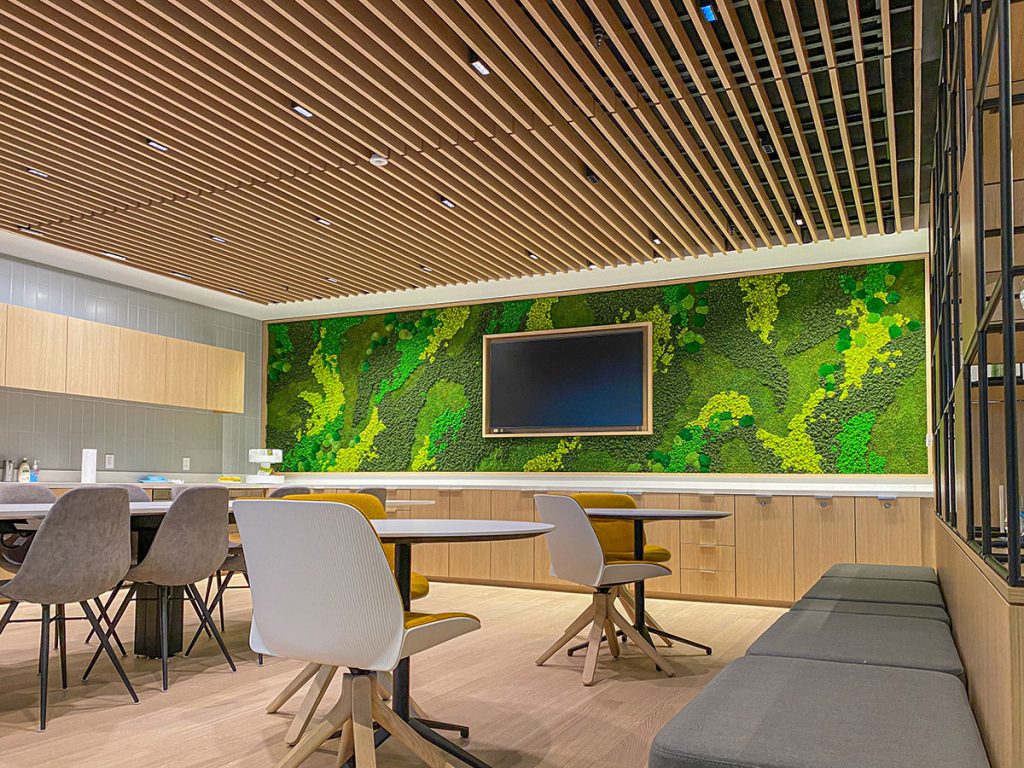Biophilic design in architecture
Biophilic design in architecture focuses on connecting people with nature to create harmonious and human-centric living spaces. Architects incorporate natural elements like plants, natural light, and water features into the design to improve well-being and productivity of the occupants of these transformative and regenerative built environments. Research has shown that biophilic design can reduce stress, enhance creativity, and increase overall happiness in occupants.
This design approach is not just about aesthetics but also about mindfully creating environments that benefit our physical and mental health.
Importance of preserved gardens
Preserved gardens play a vital role in biophilic design by bringing nature into our built environments. They provide a direct connection to the natural world, offering a sense of calm and tranquility without the maintenance aspects of living gardens.
Preserved gardens contribute to improved visual interest, reduce noise pollution, offer horniness, and promote biodiversity with their own biodiverse plant species.
Additionally, they create a visually appealing space that enhances our overall well-being while also helping people connect by being a conversation starter in these environments.
Integration of nature in architecture
To create a connection between architecture and nature, architects integrate natural elements such as plants, natural light, natural stones, and water features into building designs. This integration not only enhances the aesthetic appeal of the space but also promotes a sense of well-being among occupants. Incorporating nature in architecture helps reduce stress levels, increase productivity, and improve overall mood.
Role of plants in biophilic design
Plants play a vital role in biophilic design by connecting people to the natural world. They help create a calming and rejuvenating environment, improve air quality, and reduce stress levels. Incorporating plants in indoor spaces can enhance creativity, productivity, and overall well-being. In biophilic design, plants are not just decorations but essential elements that promote a sense of harmony and connection with nature. However, with living plants, come maintenance issues, and bug infestations. The use of preserved plants in the built environment helps the facilities team to worry about one less thing in their to do list. So, all the advantages of moss and plants but without any maintenance requirements. Best of both worlds!
Benefits of preserved gardens
Preserved gardens offer a range of benefits to biophilic design as they are perceived as part of nature by the occupants. Research shows that they can reduce stress, create connection to one’s self and environment, and increase productivity. Furthermore, preserved gardens create a connection to nature indoors, which can enhance overall well being and mood. Some advantages include but not limited to:
- Stress reduction
- Improved air quality
- Improved air quality (by the ones with the right 3rd party credentials)
- Increased productivity
- Faster learning & healing
Psychological impact of nature in design
Studies have shown that including natural elements in design, like preserved gardens, can positively impact our mental well being. People tend to feel more relaxed and happy in spaces that incorporate nature. This connection to nature can reduce stress, increase focus, speeds up healing times of patients, enhance creativity, and improve overall mood and productivity.
Design principles of biophilic architecture
Biophilic architecture aims to connect people with nature through buildings. Here are some design principles to incorporate nature into architecture:
- Sight: Embrace natural light and views of greenery.
- Material: Use natural materials like wood, plants and stone.
- Color: Integrate earthy tones and natural colors.
- Nature Analogies: Include patterns or shapes and even sounds inspired by nature.
Sustainable practices in biophilic design
Sustainable practices are essential in biophilic design to create spaces that are friendly to the environment. Some sustainable practices commonly used in biophilic design include using recycled materials, 3rd-party-tested-material-health proven material use, energy-efficient lighting, green roofs, reduced waste during the life-cycle of the building and rainwater harvesting systems. These practices not only benefit the environment but also contribute to creating healthier and more aesthetically pleasing spaces.
Creating harmony with nature
When designing spaces with preserved gardens, you aim to create harmony with nature. Preserved gardens are essential in biophilic design as they bring elements of nature into built environments, promoting a sense of tranquility and connection to the outdoors without the hassles of the upkeep of living plants. The presence of preserved gardens helps in reducing stress levels, increasing productivity, and improving overall well-being. Incorporating preserved gardens in architecture and interior design is a powerful way to enhance the human-nature relationship and create spaces that uplift and rejuvenate.
Case studies: Preserved garden projects
Preserved gardens have been used effectively in various biophilic design projects to bring nature into urban spaces. A case study in Singapore showcased how a preserved garden on a high-rise building’s amenity space significantly improved the occupants’ well-being and connection to nature. Another project in Milan, Italy integrated preserved gardens into office spaces, resulting in increased productivity and overall satisfaction among employees. These examples demonstrate the versatility and positive impact of preserved garden projects in enhancing biophilic design principles.
For more information on this subject and more, please visit our website: www.gardenonthewall.com


